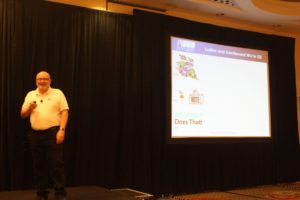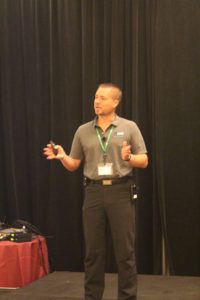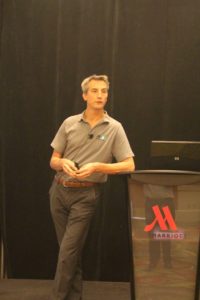The General Assembly Meeting is an opportunity to meet face-to-face with members, end-users, and the press. Principally an open forum for discussion, the event provides members with access to other members in a noncompetitive setting. This year was particularly engaging with many notable presentations on the current state of the organization as well as its future direction.

PI North America Chairman of the Board Michael Bryant kicked off the meeting with a Welcome and Introduction. During his presentation Mr. Bryant introduced themes that would become the foundation for the rest of the gathering. He touched on the influence of millennials in our industry, how consumer electronics are shaping the design of automation devices, and the future of industrial networking.
Executive Director Michael Bowne then took the stage to present a report on the status of the organization and where it is headed in the next year. You can read more in the introductory article to this issue of PROFINEWS.

Manager of the PROFI Interface Center, Torsten Paulsen, presented their results as a PI Test Lab, Competence Center, and Training Center. This year at the Lab, 80% of devices tested have been PROFINET (compared to PROFIBUS), and the Lab added PROFINET IRT testing services. That ratio carries over to the number of Certified Engineers trained over the last ten years: 80% PROFINET to 20% PROFIBUS DP/PA.
The Chairman of PI, Karsten Schneider, had much to discuss in his presentation:
- News from PI
- Industrie 4.0
- Time Sensitive Networking (TSN)
- Asset Management Record
- IO-Link
Some highlights included mention of the fact that 2015 was the first year we saw more PROFINET nodes sold than PROFIBUS nodes. FDI (the combination of FDT/DTM and EDDL) is now an IEC standard and the tools and components are now available. There is still the potential for further cooperation, for example in harmonizing device parameters.

Within PI, we have been adding value to data for a long time by providing semantics. For example, raw data from a temperature sensor might be “72”, which provides little context. On the other hand, “72°C” provides more useful information. Going further, “72°C currently above 70°C upper limit”, gives further value to the data. Application Profiles are one of the means by which semantic information is attached to raw data. More Application Profiles are planned for the future; for example the Asset Management Record, which allows users to gather such information over PROFINET in a standardized way.
TSN is another hot topic currently being addressed within PI, under our Industrie 4.0 Working Group. It functions by standardizing in IEEE many of the features already available within PROFINET like Synchronization, Low Latency, Robustness, and High Availability. One critical question raised was: how are TSN networks configured? If it’s a ‘simple’ 700 step process [note: sarcasm], then adoption might not be as high as speculated.
Finally, the growth of IO-Link appears to have reached an inflection point where it is starting to take off. Twenty new members joined the IO-Link Consortium so far this year, bringing the total to 132 different companies. Currently, work is taking place to introduce IO-Link Safety and IO-Link on PROFINET.
